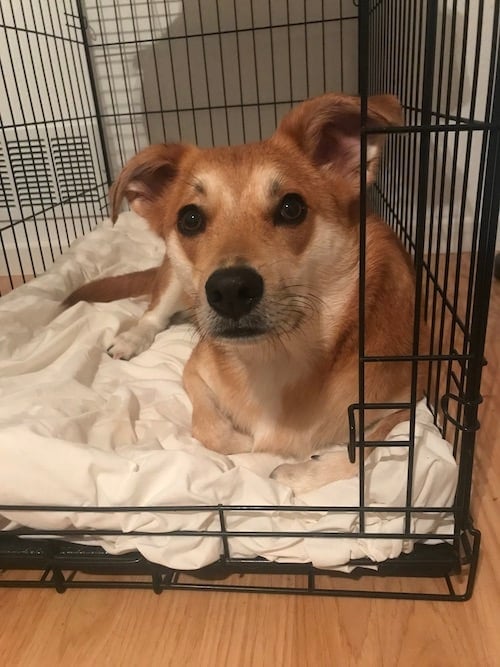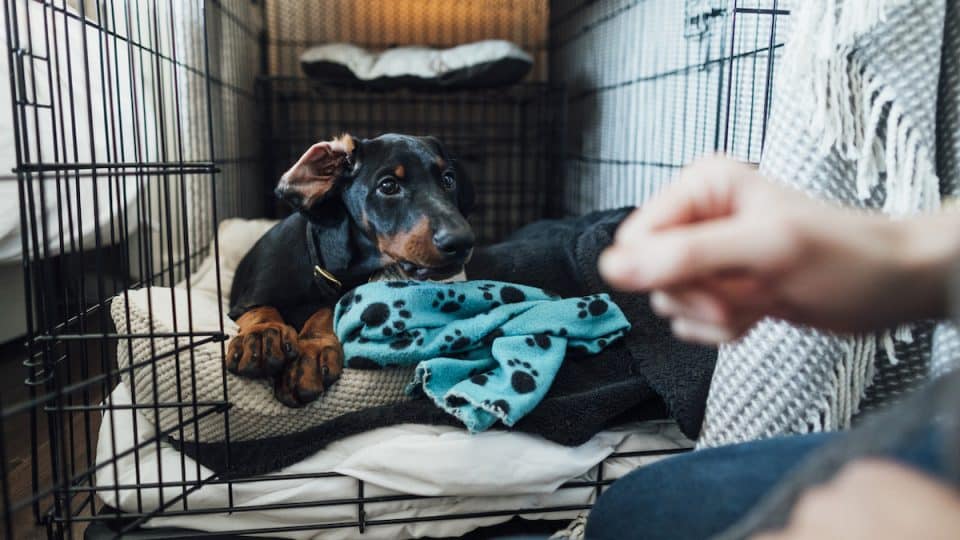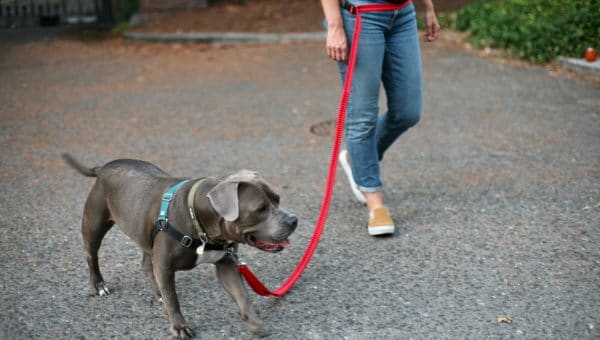- This post contains affiliate links. Read more here.
- Not a substitute for professional veterinary help.
Even though crate training is often associated with puppies, there are plenty of reasons to crate train an older dog. Maybe you have a new rescue who’s come into your life. Or perhaps you need to prepare an untrained dog for traveling in a crate. Whatever your reason, we’re here to assure you that crate training an adult dog is possible.
To make life easier on your end, we’ve consulted the experts for crate training tips. Here’s what to expect, the steps you can take, and solutions for common challenges that might pop up along the way.
What’s Different About Crate Training an Older Dog?
You’ve probably heard that you can’t teach an old dog new tricks, but this isn’t exactly true. You can train adult dogs to use a crate and even enjoy it—the process may just look a little different from training a puppy.
“Adult dogs and puppies learn differently due to differences in cognitive abilities, physical capabilities, and behavioral patterns,” explains Dr. Alex Schechter, DVM, and founding veterinarian of Burwood Veterinary. “Adult dogs have more developed brains and established habits, but may resist change.”
Dr. Schechter points out that some adult dogs may have already developed negative associations with crates from past experiences and will need extra patience and positive reinforcement during training. He adds that senior dogs may also require modifications due to physical limitations or cognitive changes.
You could also be looking at a different timeline with adult dogs. Typically, puppies adjust more quickly than adults because they’re at a developmental stage where they’re adaptable and open to new experiences, Schechter tells us. Adult dogs, on the other hand, might need a bit longer to change their habits.

Rover test pup Roo enjoys crate training when treats rain down from the sky.
Step-by-Step Instructions To Crate Train an Older Dog
When you’re ready to crate train your adult dog, patience is key. If you rush the process or push your adult dog before they’re ready, you risk traumatizing them. Moving too fast could cause a setback in the training progress. Instead, go at your dog’s pace while building trust and positive feelings toward the crate incrementally.
“A good crate training plan will spend a fair amount of time helping the dog feel comfortable long before closing the crate door,” says Amanda Dwyer, certified fear-free trainer and owner of Westward Hound. With Dwyer’s help, we’ve laid out the steps for crate training your adult dog—followed by tools and tips for overcoming common crate training obstacles.
1. Choose the best crate and location
Pet parents have a lot to consider when choosing a crate for their adult dog. For starters, you’ll want to ensure it’s the right size, so your dog can stand, turn around, and lie down comfortably in their crate.
The material also matters. If your adult dog is anxious, they may appreciate a crate that provides more coverage, like a plastic or wooden crate. If you have a senior dog with arthritis or mobility issues, opt for a crate with easy access and a low step-in entry.
It’s helpful to make the crate as cozy and inviting as possible. Include a joint-supporting crate bed, water, and a favorite chew toy to entice your pup. Place the crate in a quiet, low-traffic area of the home—but not so far away that your dog feels isolated. A bedroom or living room are usually good choices.
2. Form positive associations with treats
Initially, the focus will be on getting your dog comfortable with entering their crate. Leave the door open and toss in some treats to establish that good things happen in the crate.
“Most dogs will enter if treats are tossed toward the back of the crate. Let them voluntarily get them in their own time,” advises Dwyer.
If your dog hesitates to go completely inside, see if they’ll go halfway by tossing treats into the middle of the crate instead. “I like to hide extra special treats for them to discover during the early stages, like a marrow bone, bully stick, or new toy,” Dwyer adds.
3. Serve meals in the crate
When your dog is comfortable entering the crate for treats, Dwyer recommends feeding them their meals inside. At this point, the crate door should still be left open.
4. Try closing the door
“Once the dog is happily entering for a food lure, then you can start closing the door for very brief periods of time,” says Dwyer. “Start with a few seconds and then let them out.”
While they’re inside, you can continue to drop treats into the crate every few seconds to help extend the length of crate time they can handle. But don’t keep your dog in there too long, Dwyer warns. “During this early phase, your goal is to let them out long before they get bored or unhappy with being contained,” she says.
5. Work up to longer periods of crate time
When your dog is content with being crated for a minute or two, you can start building up to longer periods of crate time.
“For this step, give them a frozen stuffed KONG or other long-lasting and high-value chew to work on in their crate,” advises Dwyer. This enrichment can usually provide a good 15 to 20 minutes of distraction, during which you can start to briefly leave the room. At first, you can open the door before your dog finishes their treat. Then, gradually add a couple of minutes of crate time per training session.

Leaving the door open can help build trust when crate training your adult dog.
Troubleshooting: What To Do If…
Crate training an adult dog is not without its share of challenges. Here’s how to handle common issues.
Whining or barking
If your dog has recently gone to the bathroom and they’re otherwise comfortable and safe, excessive whining could indicate you’ve taken things too fast. Don’t get discouraged! Go back a few steps, and try moving a bit slower. Dwyer also recommends leaving the door open while tossing treats in to build your dog’s trust.
Overcoming negative past experiences
When training a puppy, you’re usually starting with a clean slate. However, this may not be the case for an adult or senior dog. “If the dog is a recent rescue, they may have been forced into crates for transport, or they may have been unsuccessfully crate trained in their previous home,” Dwyer points out.
One of the best ways to overcome negative associations with the crate is through enrichment. “Enrichment is your best friend for crate training, especially if your dog is on restricted activity due to medical issues,” Dwyer tells us. To distract your dog while building positive associations with crate time, offer them an interactive toy filled with food or treats. Lick mats, KONG toys, and West Paw Toppls are all excellent for this purpose.
In addition, you may want to consider a crate cover to shut out stressful stimuli or a pheromone product to keep your dog calm. Some dog parents swear by soothing heartbeat toys, which are often reported to alleviate canine stress.

Puzzle toys, like a stuffed KONG, can provide a distraction and mental enrichment while your adult dog is in his crate.
What To Do If Crate Training Just Isn’t Working
If you’ve tried every trick in the book, and your dog is still struggling in their crate, don’t give up yet! Instead, seek advice from an expert. A professional trainer or veterinary behaviorist can provide feedback and tools that can help you work with your dog.
However, it’s important to understand that even with professional training, there will be some dogs who simply cannot adjust to a crate. For Dwyer, this includes dogs with separation anxiety and confinement phobias. “These panic disorders do not go away without intervention, and confining the dog in a crate often exacerbates their symptoms.” The following behaviors could indicate your dog is suffering from serious separation anxiety:
- Excessive barking or howling when left alone
- Destructive chewing or scratching, especially around exit points (windows and doors)
- House soiling or crate soiling, when otherwise housebroken
- Drooling, vomiting, trembling, and excessive pacing
“If your dog is completely content being left alone but is simply resistant to being in their crate, it’s fine to just skip crate training and rely on a dog-proofed room or another style of confinement, instead,” Dwyer informs us.
You can use a sturdy baby or dog gate to block off a laundry room or hallway where your dog can stretch and play without the need for a crate. Dog exercise pens (like X-pens) are also useful for this purpose.
“If your main need for a crate is for transport, there are plenty of dog seat belts on the market that can safely secure them while driving,” Dwyer adds.






